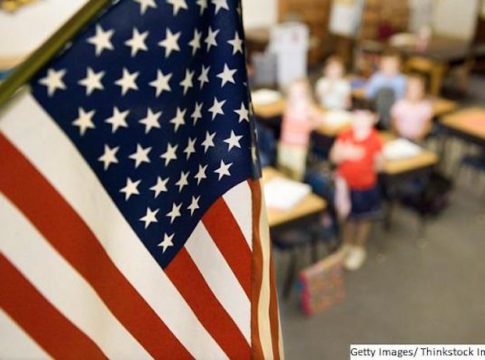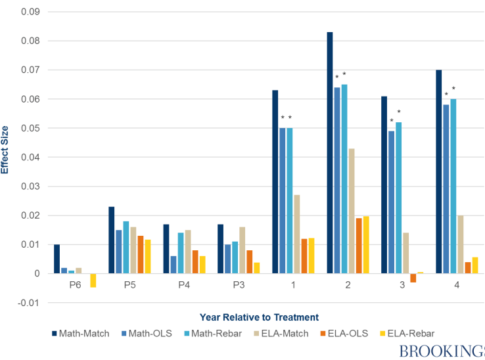Of all of the responses to my “you’re-not-college-material” post, there’s one I find most compelling—and worrying. Namely, kids who aren’t “college material” aren’t “career- and technical-education material” either. Springpoint’s JoEllen Lynch says it well:
It’s a myth that CTE meets the needs of low performing kids from low performing schools. So, it depends on what problem we are trying to solve. Are we just looking for more models for students who enter high school fully prepared, or are we trying to create models that will address the needs of kids who are not? I think many people feel that CTE is an answer for the unprepared; this notion is not based on data or an understanding of the demands of good CTE schools.
I stand corrected. Since I wrote my Slate piece, I’ve learned much more about high quality CTE programs, including one I visited in Fordham’s hometown of Dayton, Ohio (the Ponitz Career Technology Center). This high school (with close ties to Dayton’s excellent community college) is even selective, only accepting incoming freshmen who score proficient on Ohio’s math or reading tests and who stayed out of trouble in middle school.
Assuming that Dayton is not an outlier and that Lynch is correct, this raises an obvious question: if CTE is not “an answer for the unprepared,” what is?
Cue RiShawn Biddle of Dropout Nation. Biddle was not happy with my “college-material” essay, arguing that it earned me a one-way ticket out of the school-reform movement. I was guilty, in his words, of “declaring that we should subject children from the communities that have suffered the worst from the nation’s education crisis—and from the racialism that has been the Original Sin of both American public education and the nation—to low expectations.”
Biddle would argue that nobody should enter high school unprepared. I don’t disagree; that’s absolutely a worthy aspiration. But wishing doesn’t make it so. Consider the facts.
According to the National Assessment of Educational Progress, just 36 percent of students nationally are proficient in math at the end of eighth grade; roughly the same proportion is proficient in reading. Assuming that “proficient” on the NAEP is roughly akin to “on track for college and career readiness” (a safe assumption), that means about half to two-thirds of America’s students are currently entering high school unprepared.
But it gets worse. The corresponding numbers for black and Hispanic students are tragic: just 14 percent of blacks and 21 percent of Hispanics are proficient in math at the end of eighth grade; for reading, it’s 17 percent and 22 percent, respectively. And how about the big urban districts that are the focus of much of school reform? Consider Cleveland: only 9 percent of its eighth graders are proficient in math, and 11 percent are proficient in reading. In other words, one in ten entering freshmen is on track for success in college or career.
Yes, that’s an outrage that we should do our damndest to set right. So let’s assume that we redouble our efforts at school reform in preschool through the eighth grade: Push the pedal to the metal. High-quality early-childhood education. Excellent instruction in phonics and the fundamentals of mathematics. A content-rich elementary-school curriculum. Great teachers in the schools that need them most. Challenging courses for everybody in middle school. Many more high-quality choices. (Cleveland is trying earnestly to do all of these things, by the way.)
Do Biddle and others really think we can ramp up the number of “prepared” ninth-grade students in big cities from 10 or 20 percent to 100 percent? I don’t, and I don’t think that means I must turn in my reform credentials. It just makes me realistic—and somewhat competent at math.
So let’s assume, then, that for the foreseeable future many of our high schools are going to have a heck of a lot of entering students who are prepared for neither a true college-prep curricular route nor a high-quality CTE program. The high school will do its best, but in all likelihood, a great many of these young people will graduate (if they graduate) with low-level skills that won’t leave them prepared for college or a well-paying career. What should we do with these students while they are in high school? What education offerings would benefit them the most?
Do we have the stomach to face up to these painful questions? It seems to me we avoid them. Instead, we encourage such students to muddle through “on-level” quasi-academic courses in large comprehensive high schools. Eventually, they drop out or get labeled as “over-age and under-credit.” At that point, various credit-recovery (or dropout-recovery) initiatives kick in. If the students are diligent and lucky, they squeeze out a credential. And then?
That’s hardly a strategy, a system, or a solution. And keep in mind that in some big urban districts, we’re talking about upwards of 80 or 90 percent of today’s kids—and, for all of our reforming, big fractions of tomorrow’s, too!
Here is where I’m supposed to lay out my grand solution for this vexing problem. Would that I could, but in truth, I don’t know what to do for these students beyond beefing up the elementary and middle schools so as to minimize their numbers. Does anyone? If it’s not college prep, not CTE, not the feckless “muddle-through” approach we have now, what is it? Education innovators: I’m all ears.
-Michael Petrilli
This first appeared on the Fordham Institute’s Flypaper blog.




